Visiting the "Parco dei Mostri" of Bomarzo, conceived by Pier Francesco Orsini in memory of his late wife Giulia Farnese and created by Pirro Ligorio, is equivalent to making a real metaphysical journey, stimulated by the numerous hermetic-alchemical suggestions, in the abysses of the human interiority.
article and photos by Robert Eusebius
cover photo: statue of Neptune in Bomarzo
Those who descend from Florence to Rome on the E 35, making a detour to Orte (province of Viterbo) and having time to dedicate to the mystery, can visit the Sacro Bosco di Bomarzo; and we must say that the sensations that can be experienced are up to the words that the great art critic Bruno Zevi said about the monumental complex:
«In Bomarzo the scenic fiction is overwhelming; the observer cannot contemplate because he is immersed in it, in a gear of sensations (…), capable of confusing ideas, of emotionally overwhelming, of involving in a dreamlike, absurd, playful and hedonistic world. "
Surrounded by greenery, Bomarzo is located in the heart of Tuscia between the extreme north-eastern slopes of the Cimini mountains which are the origin of the rocky spur of peperino on which the town of Bomarzo and the wide valley of the Tiber river lie. Its sacred wood for which it is famous is adorned with numerous basalt statues designed and built around the 1560th century. It was created between 1585 and XNUMX. Monsters, gods and mythological animals live there. The work was commissioned by the prince Pier Francesco Orsini who dedicated it to the memory of his wife, Gulia Farnese. It was built by the architect and antiquarian Pirro Ligorio, the same one that will become famous for the design of the Villa d'Este in Tivoli.
That was the time when under the stimulus of the academies and cenacles Renaissance, we were preparing to transform the sciences and to allocate more refined studies to the deepening of knowledge of the highest level, with the intention of traveling towards and beyond the "Pillars of Hercules" of knowledge but also and above all of the knowledge of themselves. On the other hand Pier Francesco Orsini known as Vicino, after the military career that saw him engaged until 1557 following the papal troops, he retired to the family palace [1] and from that moment he devoted himself to the construction of the forest. He was an erudite character, a refined man of letters, who loved to surround himself with humanists, philosophers and alchemists in close contact with the followers of a Neoplatonic academy of hermetists to which they belonged. Cosimo de Medici, Pico della Mirandola and Marsilio Ficino.
At that time theArs Regia it was cultivated in the European courts following that idea of change that matured a new way of conceiving the world and oneself, developing the ideas of humanism, born in the literary field in the fourteenth century. The scholars of the Renaissance had had the merit of translating the best alchemical works that were spreading thanks to the invention of printing that were read and interpreted in the academies and cenacles of the European courts. Among the noble families there was a competition to interpret in theirs domus vivendi intellectual ways and aspirations translated into real terms. Here then appear in the noble residences to their external crown, the famous alchemical gardens in which the symbolisms of the Royal Art were structured in the forms and meanings that best express an allegorical method, whose new perception of man and the world around him would have been very different from that of previous centuries.
The Magic Wood of Bomarzo formerly known as the Wood of Wonders or grove, as Orsini familiarly called it, is all this and something more. The mysterious element that distinguishes it seems to be cloaked in ghosts, the statues seem to come from the dream world, they wear the fantastic unrealism of the myth, while in fact their roots, going back through the Gothic period up to the classical one, intertwine with ancient contributions, including oriental ones, taking on a different symbolic value through the reinterpretation of ancient traditions. The same Bomarzese territory does not lack evidence of ancient settlements scattered in the nearby woods. In places like the forest of Malano or Colle Casale they are present monuments of the Etruscan-Roman period: niches, niches, basins carved into the stone and monolithic sarcophagi in the shape of a human silhouette.
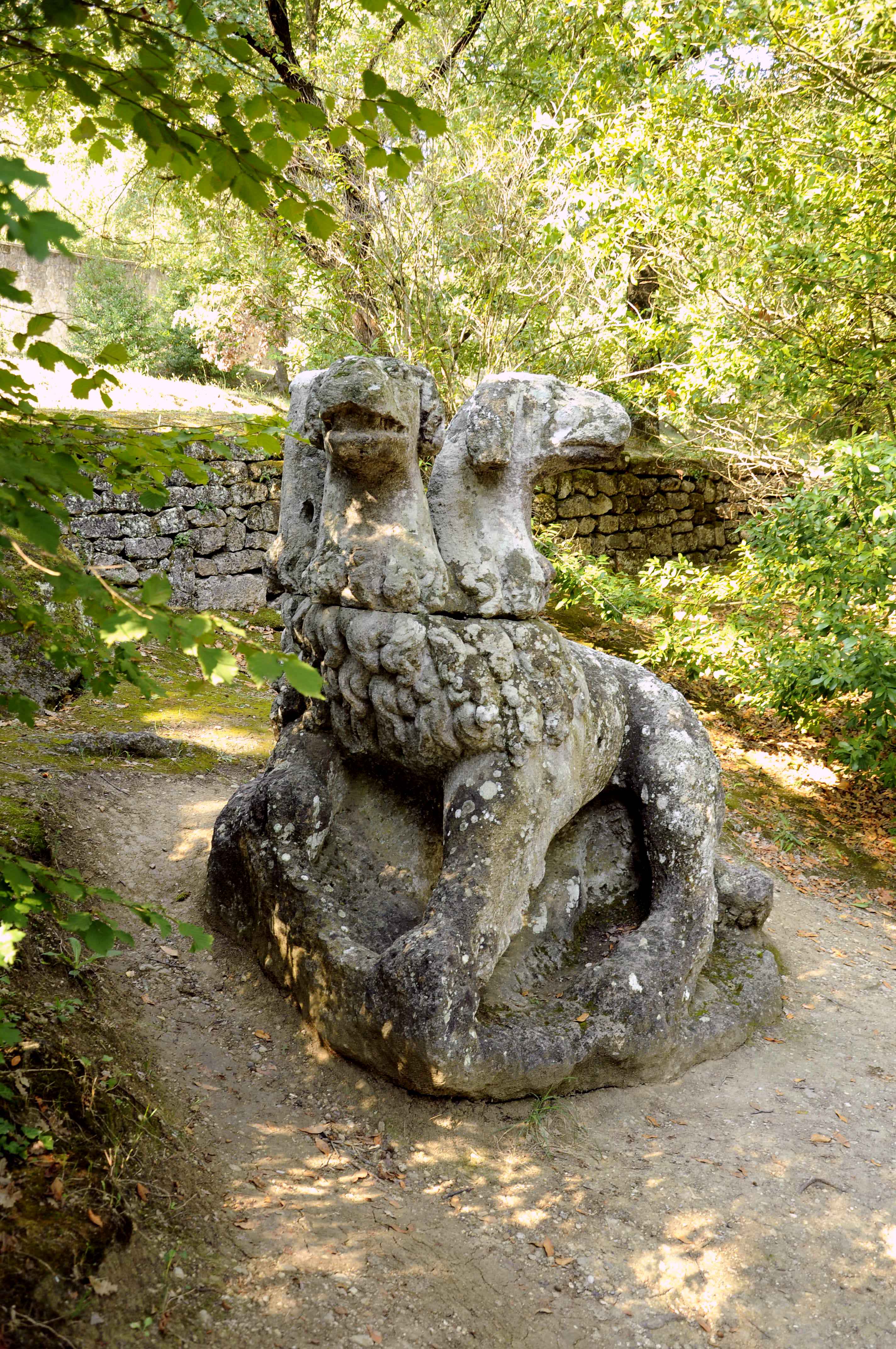
From these testimonies and ahead of their time, Prince Orsini and the architect Pirro Ligorio will manage these ideas long before the English who will translate the ideas of the poet Alexander Pope who will inspire the poem "Temple of fame" of 1711 and in 1719 will create his garden of Twickenham, the place of meditation. The wood of wonders will be something different from the contemporary gardens, built in the surroundings by other lords, such as Villa d'Este in Tivoli, Villa Lante in Bagnaia or the garden of Palazzo Farnese in Caprarola as well as in Sicilian territory the "villa of monsters" of villa Palagonia in Bagheria [2]. Some say that alongside the Orsini there was, in the conception of the garden, Michelangelo Buonarroti; however the truth may be, Orsini and Ligorio will anticipate one of Pope's rules or the skilful arrangement of surprises (both optical and narrative) since the Bosco di Bomarzo is full of scenarios that gradually open up to the visitor.
The garden is structured as a metaphysical journey to remind man of his partially fallacious team, wrapped in the veils of Maia and by the false fears and passions that wear down man. It is the place of a return to the beginning and to nature. The garden conceived in this sense made it possible to recover, in the client's idea, a sort of lost heavenly innocence. In this dream journey, the possibility is suggested, as in a fairy tale, to rediscover the ability to wonder again in front of the processes of being, that is, the cycles of death and rebirth, the alternation of the seasons, the mystery of beauty understood as a canon. spiritual and being one with the universe. The legitimate creation considered as "natured nature" is contrasted by a nature designed as a symbol by man and for man, a sort of book of wonders, an initiatory path in order to exorcise, through intellectual domination, fears and passions by overcoming them.
The whole system seems to feed on the literary suggestion coming from the Hypnerotomachia poliphili, work of Francesco Colonna which came out in print in 1499. In fact, the horrifying and monstrous path beyond a mere monumental exploitation has an apotropaic intent. These types of symbolic systems are often encountered in mythological tales, often assuming the same function in which dreams or distant memories live or relive. Therefore, to keep at a safe distance and at bay, the sulphurous impulses of our nature. Orsini, a man of his time in all respects, ended his military career and retired in Bomarzo, dedicated himself to an epicurean lifestyle where, through this philosophy, he tried to to obtain a kind of state of grace which was to live modestly, to acquire knowledge of the functioning of the world and to limit one's desires. Philosophy that opened the way to happiness, where by happiness is meant ataraxia (liberation from fears and disturbances).
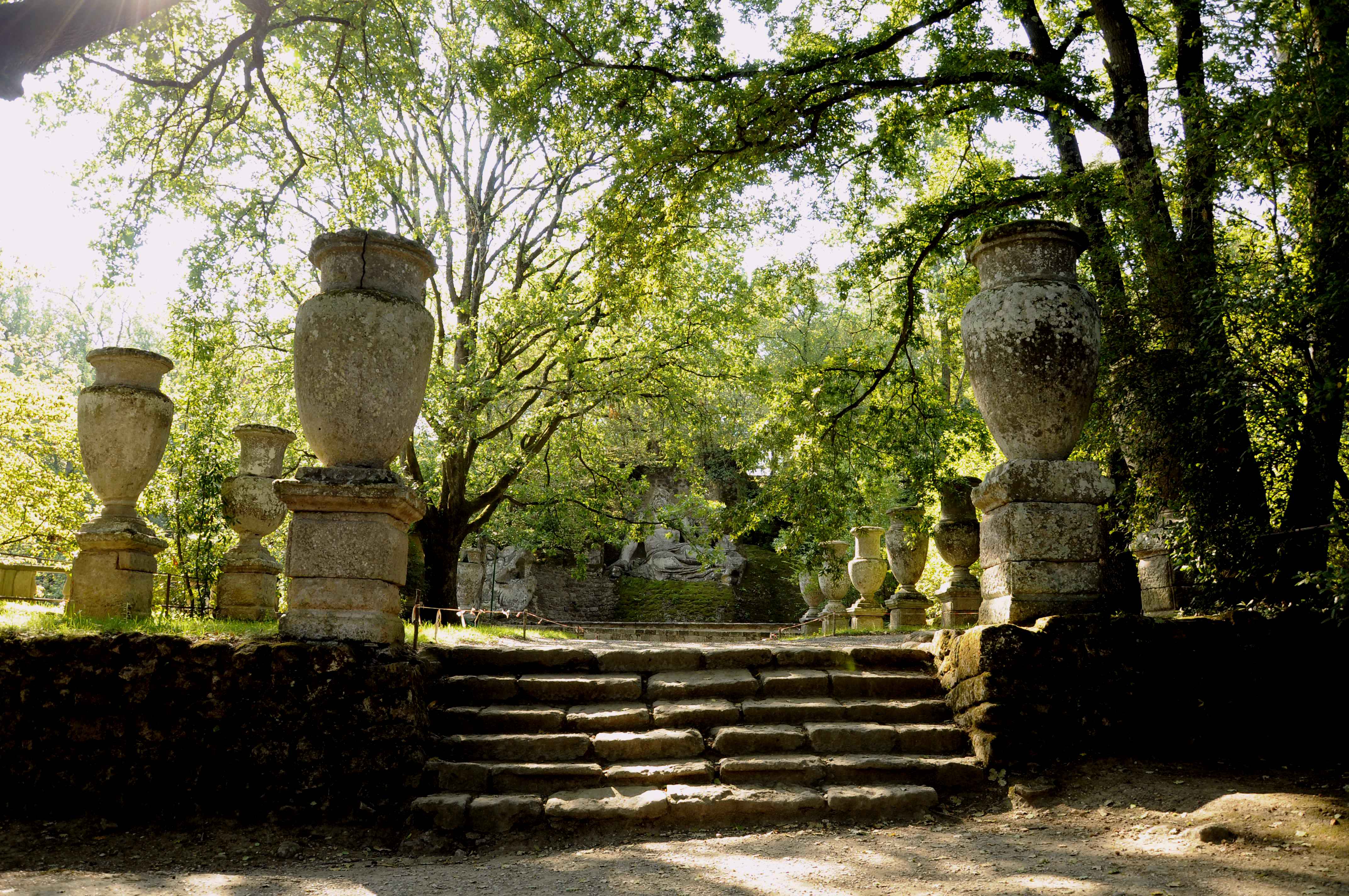
The creation of the wood was carried out in a part of the territory of the old Etruria. Orsini wanted to create a place in an attempt to quell, as he himself will say, gloom and despondency. The death of his beloved wife will leave him upset and deeply troubled so as to create an enchanted place in which to take refuge but also where it was possible not only "Vent your heart", but at the same time introducing his guests into a realm of dreams, stimulating their intelligence and making them transported within mythological references and enigmas, not always understood, which emerge as theatrical scenes, from the perspectives of the forest like so many ghosts [3]. Over the centuries it was source of interest and inspiration of various artists such as Goethe, Claude Lorrain and Salvador Dalì, Mario Praz, Maurizio Calvesi, Jean Cocteau, Niki de Saint Phalle and Manuel Mujica Láinez.
Before going into the wood of delights, we need to make some clarifications: (in primis) at its original login. Some scholars place it towards the temple, where there is actually an arched entrance, others below it near the pool and the sloping house. Today, however, the current entrance is characterized by the crenellated arch surmounted by the Orsini coat of arms at the bottom of the park. Furthermore, the current position of the various statues, which dates back to the second half of the twentieth century, only minimally reflects the original arrangement. We will do our journey through the paths of the woods taking into account a symbolic interpretation that perhaps will make some people turn up their noses: it will not, however, be a psychodrama with the staging of dreams and fantasies, myths and legends, nor the assent to a moral code with a few easy tricks, but it will be a process that we will do through an investigation into the hidden meanings and consequently the way of an inner transformation that affects the deepest part of man through and by means, at least initially, of his own senses [4].
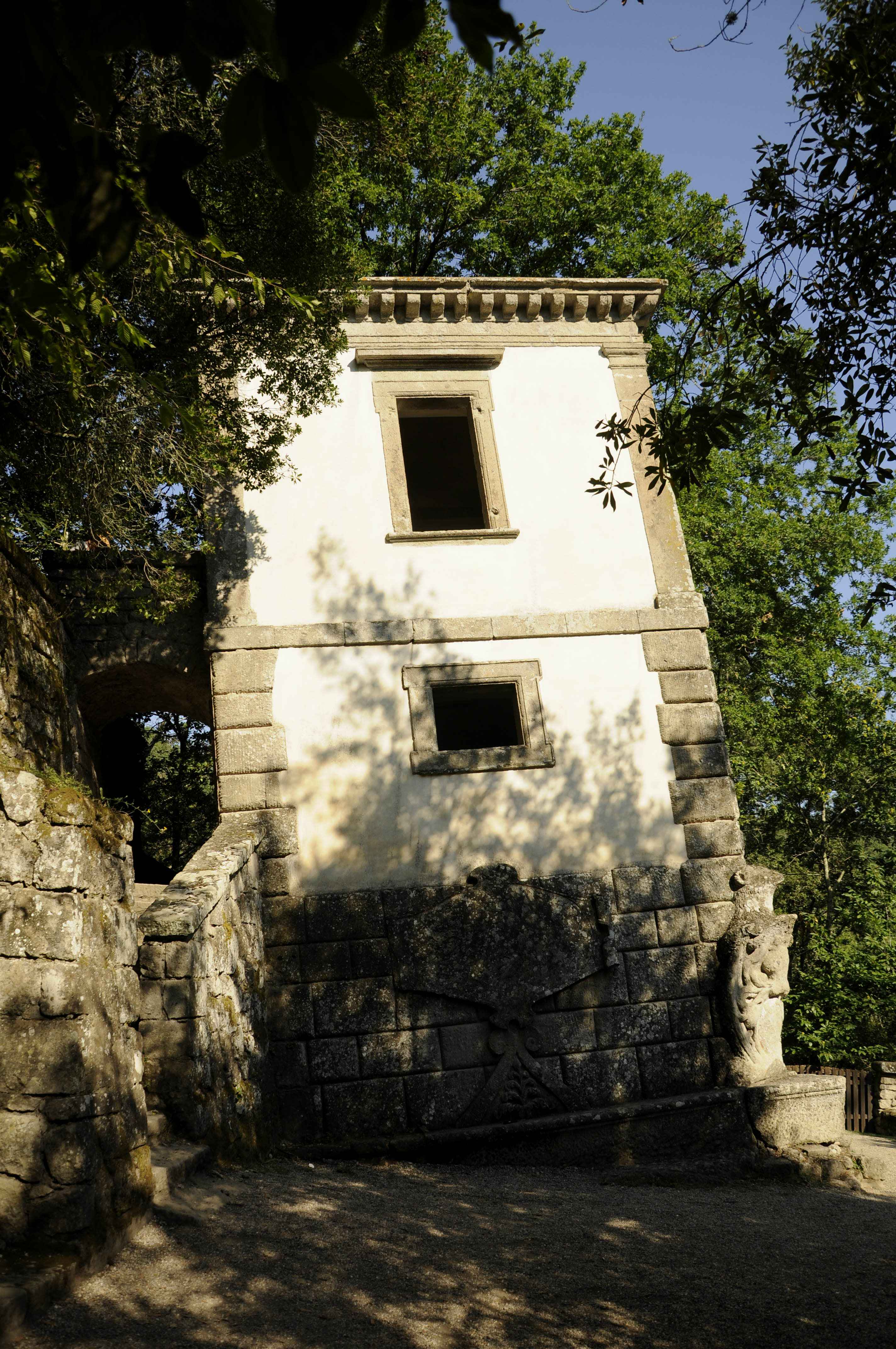
Speaking of senses, near the ancient entrance is located the "leaning house", where the friends of the Orsini who entered, felt a strong and shocking emotion, where the perception of the lack of natural balance came, and still is, upset (this seems to be the intention of the person who created it) [5] through the dizziness that one feels upon entering to seek a new balance beyond one's senses, beyond one's nature. The cartouche on one side of the building,
«Quiescendo Animus Fit Prudentior Ergo. "
it is enigmatic for the uninitiated, even if in the light of alchemical science it becomes intelligible since here we are dealing with the alchemical "quiet", which referring to its etymology refers to a new elementary stability or to indivisible unity, to the Principle. The discourse and speculation engages itself on a metaphysical front becoming very subtle and rarefied, so much so that in the ancient philosophical world it presents itself as that criterion that is enriched with an even more important and fruitful note, as the real is conceived as that quid which remains eternally identical to itself in its own determinations, in relation to the meaning of the realization of the alchemical process of one's life.
Let's go back now, retracing our steps following the proposed route in order, assuming that Prince Orsini accompanies us. It is therefore time to go beyond the entrance and let's try to meditate on the triplets that are drawn at the base of the two sphinxes that welcome us:
«Who with arched eyelashes and tight lips does not go to this place even admires the world famous piers seven. "
And on the other:
«You who enter here, mind part by part and then tell me if there are so many wonders made for deception or for art. "
And then if we speak of deception, in the idea of Orsini and Ligorio, the ordinary man is taken by illusion among many things, if he looks only with the eyes but not those of the mind, and if it is art it is therefore the art direction or alchemy. The search for another truth or in any case the will to tend towards it that accompanied, at the time of the Orsini, the visitors inviting them in a symbolic way to see beyond the diaphanous of the world.
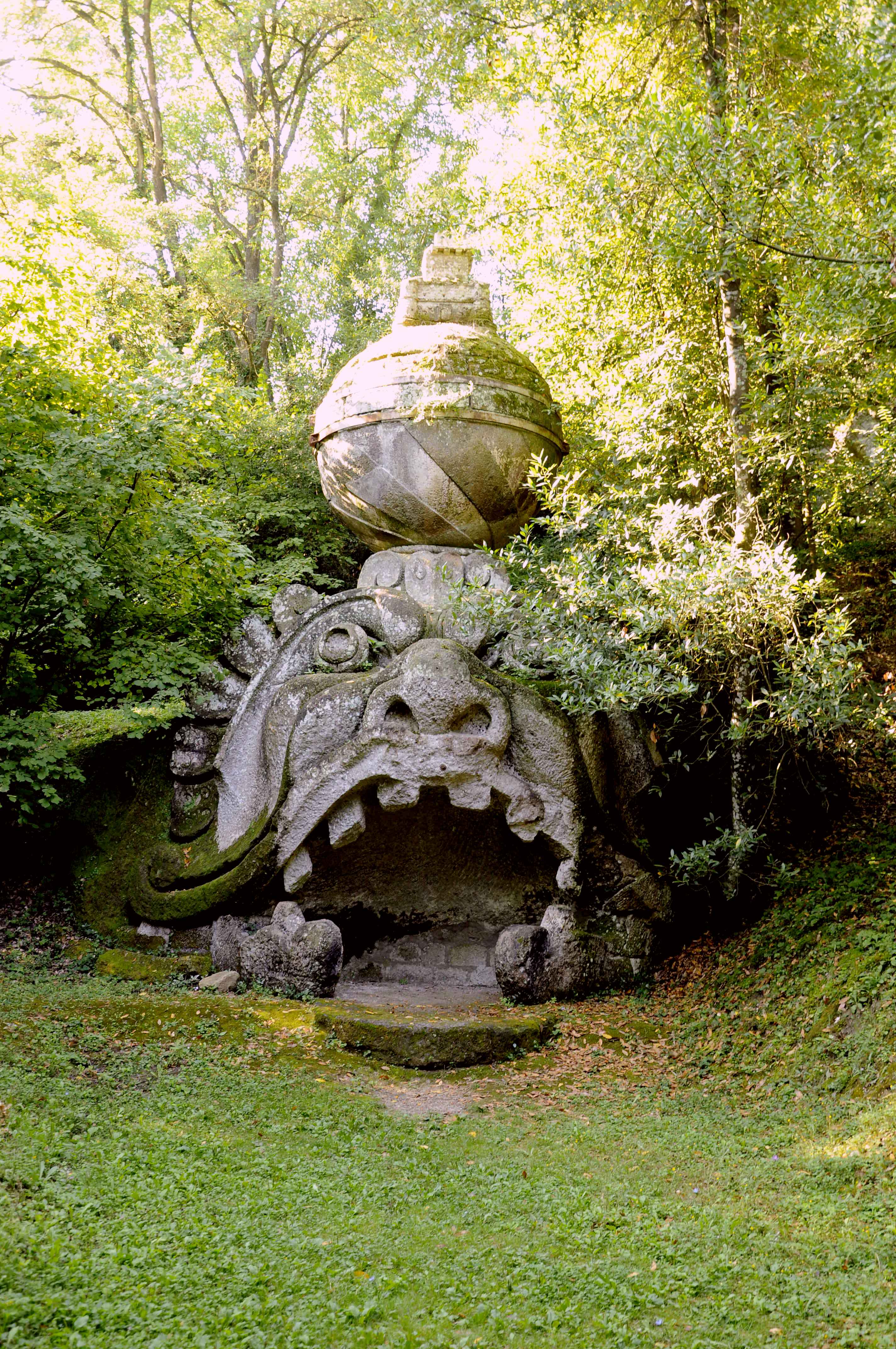
And here among the luxuriant vegetation appears, horrifying to our eyes, the first mythical creature that the track leads us to find, is the Proteus Glaucus, the sea oracle, a minor deity of Greek mythology whose characteristic was to have the gift of prophecy, but also the ability to take the appearance of any animal or the shape of different elements (fire, wind or water) to escape and who questioned him. In the context of the Bomarzese “journey”, Proteo has, according to our interpretation, a much deeper meaning than what the monstrous image of him seems to give which is given by the meaning of the different individuals with which Proteus presents himself. It will have to be allegorically related to man, where this, failing the reality of his personality, poses as one who he is not. It is only by forcing his own disposition and devouring his own individuality that he will be able to resume his nature by extolling himself (and here is the metaphor for man) from the false god or demon in which he incarnates as a character in the false comedy. of life [6]. The monster, with its mouth wide open, reminds us of the Hindu Kalāmukha [7]: the destroyer of the individual spoils, with which we hide our nature and which we fear to lose. The mythical figure echoes us in a speculative way how pursuing such consciousness can represent the state of being right. Thus, according to the Epicurean philosophy, man must be a follower of a wisdom that can procure a happy life through sincerity and simplicity without malice.

Continuing and now descending the staircase on the right of the mausoleum, this leads us towards the so-called statues of the giants: Hercules and Cacus which are in fact the largest statues in the park, on their left Orsini himself speaks to us with the inscription:
«If Rodi altier already belonged to his colossus, this is mine too
the woods still glory and it is for more not being able to do as much as I can. "
This would seem to be a reference to the city of giants: Rhodes, but perhaps with Orsini we have to get used to interpreting his statues in a different way and seeing the stories they seem to tell in a different perspective. We think that the reference is not only to the monumentality of the city of Rhodes and the parallel with the statues of Bomarzo, but in a subtle and occult form referring to the fantastic narration of the destiny of Hercules. The myth reminds us how a human being, such as Hercules was, manages to awaken the inner god and rediscover, voluntarily sacrificing himself [8], the Place in Olympus, where he will be welcomed by his father Jupiter, among other gods. A sort of potential promise even for being ordinary.
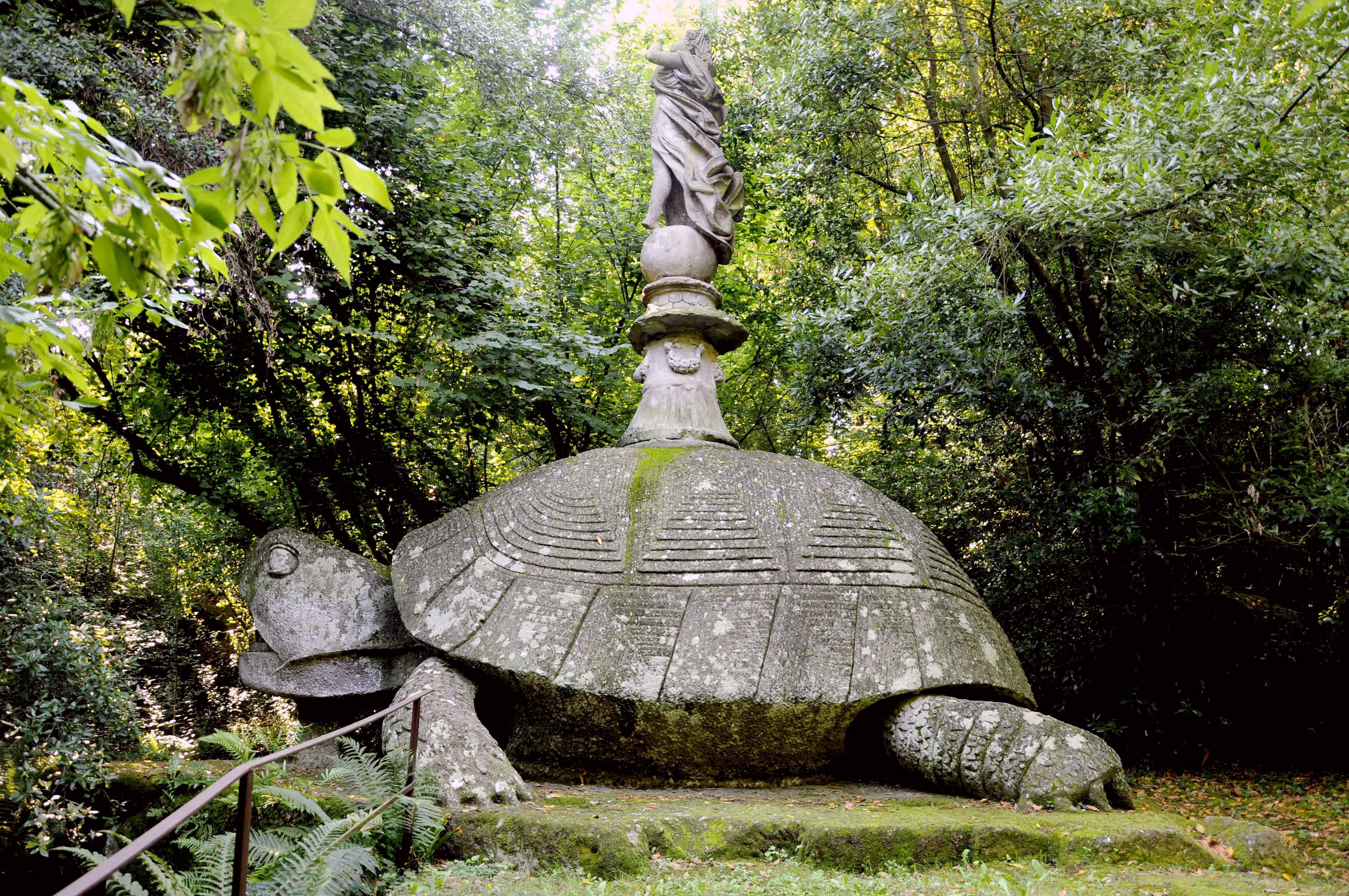
A few steps in the middle of the plants divide us from the giant tortoise statue which is surmounted by the figure of a woman in the form of a column. The tortoise, as for various other animals, in the imaginary of myths has been the patrimony of innumerable traditions, in particular the oriental ones. Apart from the Greek legend of its creation with the transformation of the nymph Chelone, the turtle represents stability and is a sacred animal that symbolically encloses five meanings: protection, wisdom, given its slowness, longevity, immortality and primordial Mother, for out of it by its division the heavens and the earth were created, while on its shell the law of creation is expressed. How could it be any different? Its characteristic armor, its peculiarity as an aquatic and at the same time terrestrial animal, its longevity and prolificacy beyond measure, have made it a mythological animal and a universal symbol. The same conformations of the carapace and the plastron, one round and the other square, have been assumed in the traditions of the East as symbols of the cosmic structure [9]: Its round domed shell representing the sky and the square plastron of the earth. In this way the turtle becomes a symbol of the manifestation and in a microcosmic sense for the being in its human possibilities. Putting it in other words each, in the various possibilities of manifestation, will evolve according to a greater or lesser tendency to distinguish between the spiritual and the material. In some representations the animal between the plates is depicted as a man to represent the mediator of heaven and earth. On the other hand, referring to a more political explanation, the tortoise leads back to Florence as it is one of the recurring ornaments of Cosimo de Medici close to Orsini due to his blood tie, albeit remote, that Cosimo himself had. Both, in fact, descended, on the maternal side, from Jacopo Orsini, Lord of Monterotondo.
However, it is probable that the two aspects coexist, even if we honestly think that the artefacts of Bomarzo are a purely symbolic plant, they represent a quantum quite particular and personal of Orsini's intellectuality, without having had the intention of a refined flattery towards power. In any case, the intellectual Orsini, despite his closeness to the papacy, will be an attentive researcher of another truth but also of the damage that the same man faithful to dogmas and undisputed truths can do to himself and to the surrounding world. warning engraved on the vase:
«Night and day we are vigilant and ready to guard this source of every insult. "
What injury should we look to night and day? The only insult from which we must defend ourselves is that of ignorance done to the intellect and to that source of eternal knowledge and of every Principle.
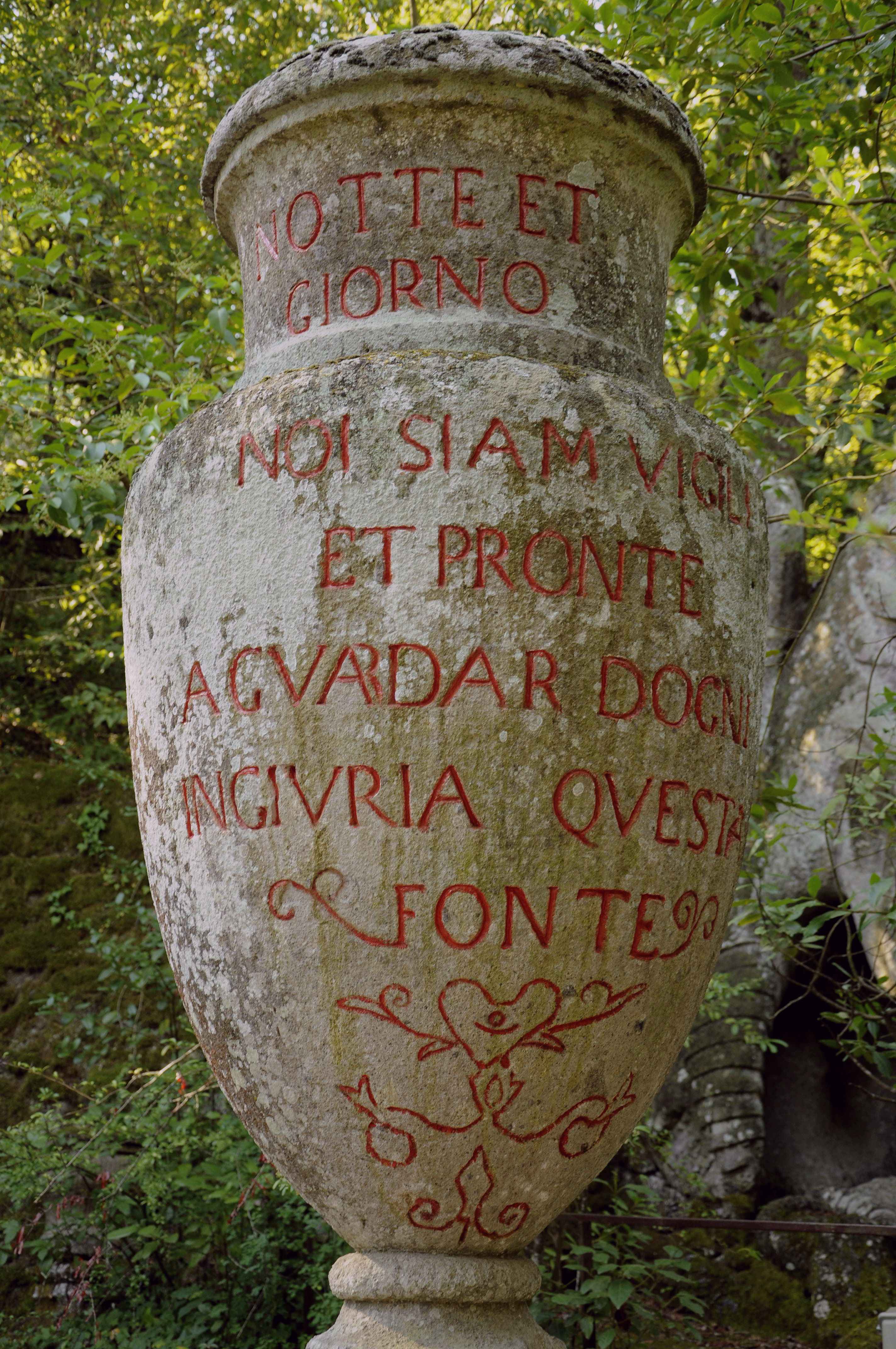
But who was Pier Francesco Orsini? We have already mentioned that he was a man of cultured and broad interests and, as we have said, tied in his own way to the Papal court, on which he depended, and to the Farnese family to which he was related through his wife. His political and religious beliefs throughout his life will be marked by an ironic and profound skepticism, which will make him hover between one faction and the other, perhaps an anarchist before its time. What interests us, in the present of this article, is his interest in the occult sciences and for his closeness to alchemists and for that idea that led him to build that strange wood so different from the gardens of those times. All scholars seem to be unanimous in indicating him as the only creator of the project that he will carry out in two stages, the first between 1561 and 1564 and with a second and more complex cycle in the following years including the most grotesque and spectacular creations. On the other hand Orsini was a curious son of his time and in his diplomatic missions or in the visitations to the papal court he will have had the opportunity to meet renowned artists such as Michelangelo, Vasari, Caravaggio etc. and the most distinguished minds of the time: alchemists, scientists, philosophers as well as theatrical machines and esoteric gardens in the stately homes, from which he will take inspiration for his wood. The same wife, with whom he evidently shared the same intellectual interests, in 1555 erected one of the oldest buildings in Bomarzo or the leaning house, and did so at the same time that Orsini was a prisoner of war.
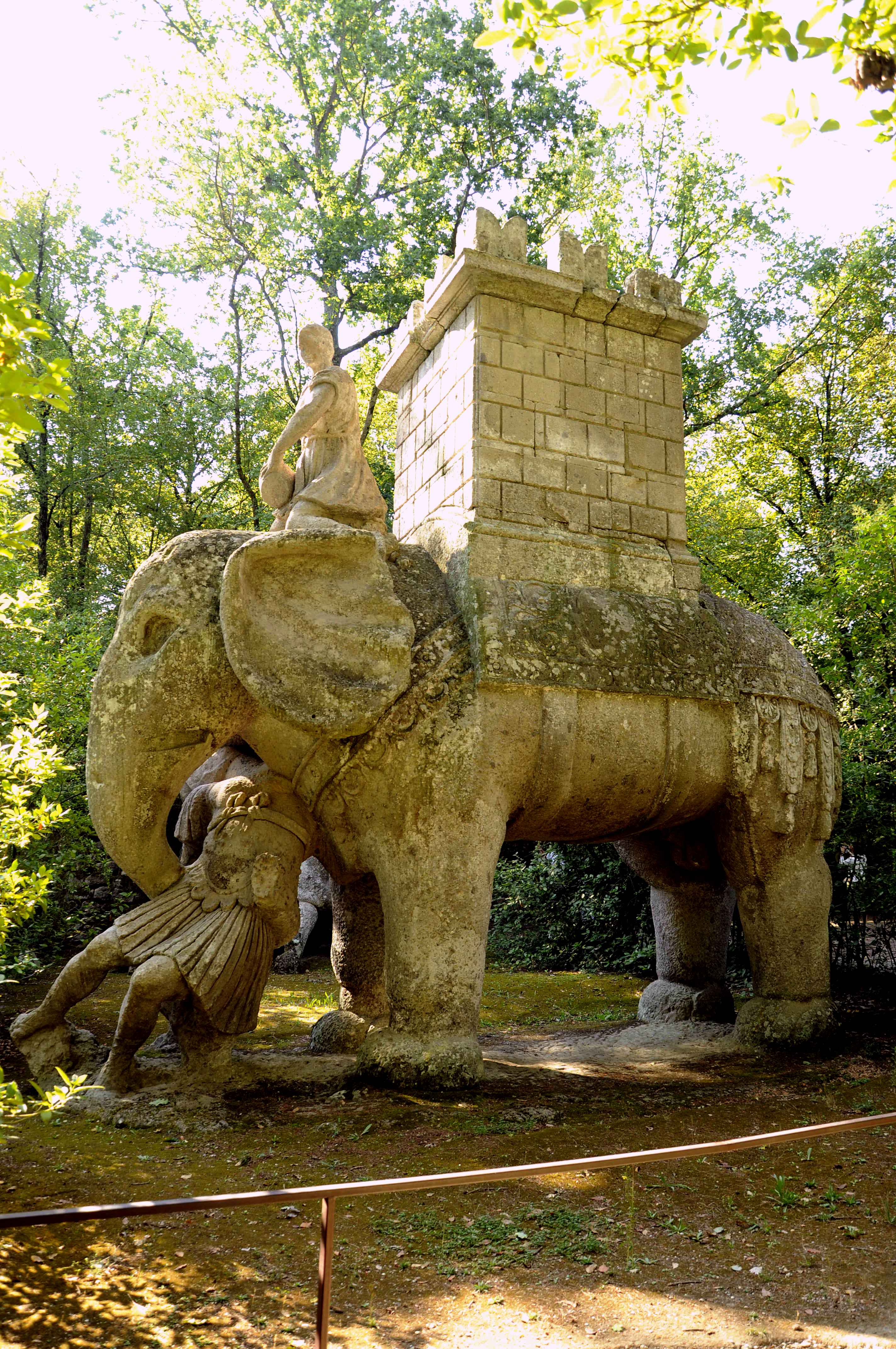
After the large vase, further on we find the elephant surmounted by a tower [10] expressly designated for military use. The elephant, a real war machine, is celebrated here in the scene where he is driven by his "Mahout" captures a Roman legionary. The explanation that is suggested is that Ligorio and Orsini wanted to represent the triumphs and defeats of Rome, while the capture of the legionnaire would suggest the victories of Hannibal, the most dangerous enemy of Rome. However, this interpretation seems to us to be much more political in some ways. In fact, if we pay attention, the battlements on the war tower on the elephant's back are Ghibelline battlements, and here, since the whole Bomarzese layout is a great enigma, we attempt a reading by allusion. The historical chronicle tells us, and we have already mentioned, how Orsini was rather restless from the point of view of fidelity to the pope, from which he had somehow distanced himself in particular after the massacre of 1557 perpetuated by Pope Paul IV against the town of Montefortino and from the excessive exteriority and worldliness of the papal court of which he will say to be hypocritical. We therefore lean towards a subtly critical meaning where Orsini seems to censor the inadequacy of Romanism in favor of a Ghibelline idea. The legionary could therefore be the symbol of papal Romanism while the elephant would represent, in addition to various qualities, the royal power.

Continuing our journey, we find almost halfway the statue of the dragon attacked by three beasts: a dog, a lion and a wolf. It seems quite logical to make a comparison of these with the three beasts that blocked Dante's way in the Divine Comedy, namely a loin, a lion and a wolf: lust, pride and greed. However, the comparisons do not end here because if the Divine Comedy is a path to climb "the delightful mountain" through the pains of hell to reach liberation, Bomarzo too must be considered a path through sapiential experiences of the mystery sciences towards knowledge. In the symbolic iconography used by all traditional forms, one of the most prominent places, in their various positive and negative interpretations, is conquered by the reptile family. They are represented both as snakes be like draghi, which from the myths of a legendary past have been perpetuated in the sacred texts, also grafted onto popular folklore as interpreters in fables and fairy tales.
In pre-Christian and Christian Western mythological iconography, snakes are characterized by an evil value that embodies the demonic powers when not the devil himself. They have an evil and devious aspect, beings that the popular imagination poses as cave dwellers, however they appear with a particular role both in decorative art and in the various expressions of craftsmanship. As far as the Christian tradition is concerned, it is enough to remember the hagiographic legends of San Michele and San Giorgio among the best known. The most ancient legends, however, bring us back to a time where the dragon, in particular, played a different role with a value opposite to that which Christianity will attribute to it and which will be assimilated by the alchemical and hermetic sciences. In times before Christianity, in the Far East, the dragon was and still is today in Eastern folklore, far from having this negative aspect, being connected to the Creator Word, that is, to God himself. This double aspect, evil and beneficial, which we have already encountered at other times for other symbols, must suggest a double interpretation that at times must be kept in mind as an alternative to what seems to appear at first glance. The dragon expresses in the alchemical sciences the idea of transformation, of evolution, of the Great Alchemical Work applied both to brute matter and to the Individual [11].

What we thought about the dragon and the beasts, that is the symbolic representation deriving from a reminiscence of Dante, Orsini seems to have also had it for the great ogre mask on which, unlike the epigraph that we read today ("Every thought flies"), Originally there was engraved, as reported in a drawing of 1598 by Giovanni Guerra:"Abandon all hope or you who enter». From an iconographic point of view this mask derives from Italic mythology and was the ruler of the Underworld and the devourer of men along with his monstrous dog Cerberus. The use of the term "Orc" to designate a man-eating monster is documented in Italian since the thirteenth century. This character appears in Ariosto's Orlando Furioso, who, evidently inspired by the Odyssey Polyphemus, describes a monstrous blind giant. Having said that, it seems to us that in the Orsini found there was the idea of inserting a recurring motif in the general layout of the wood, which is that of step over, as if he wanted to exorcise what he had personally suffered. And here then, beyond the great door of death we will also find Cerberus who represents the past, the present and the future and that it prevents the living from entering and the dead from leaving.
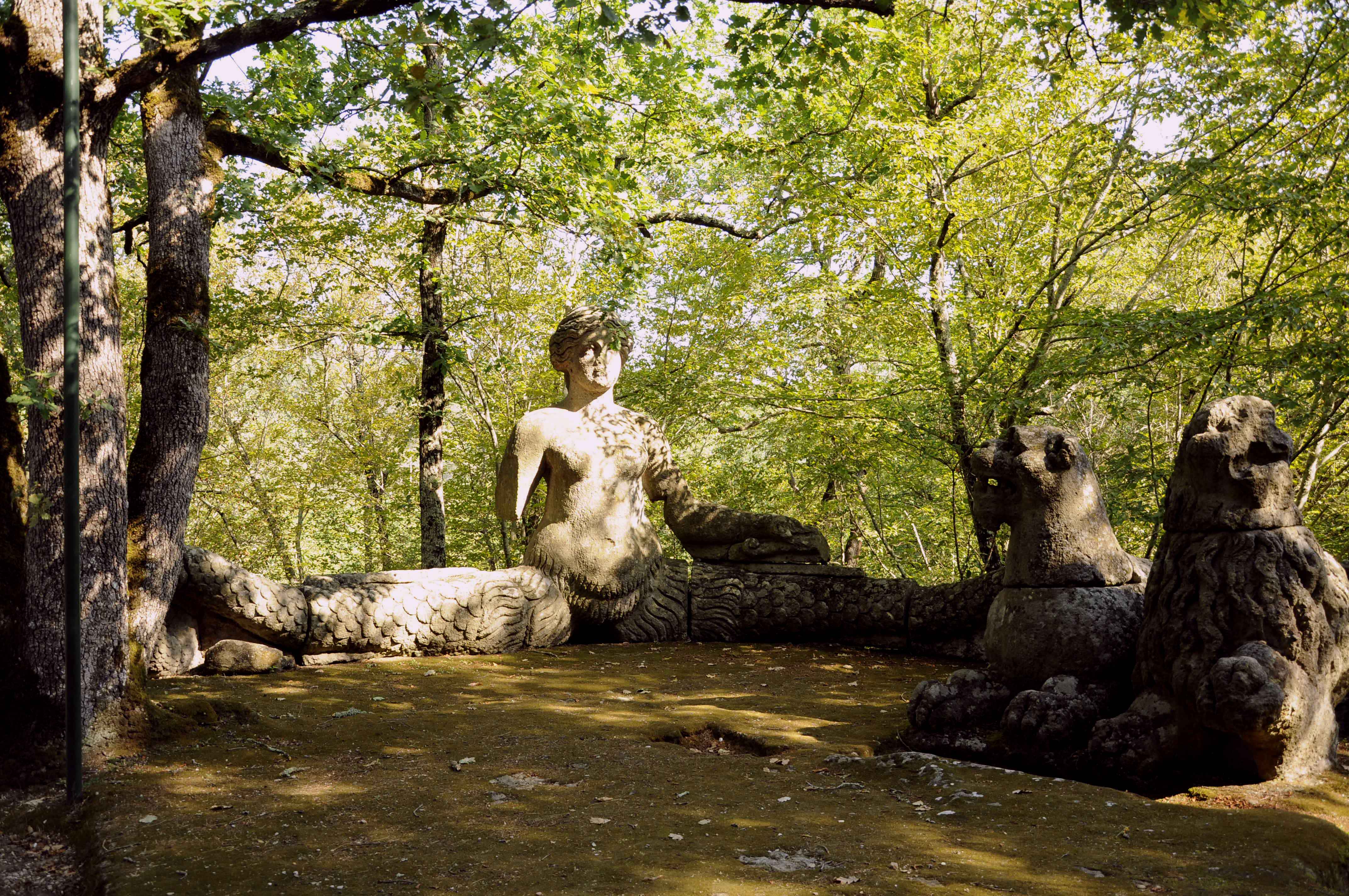
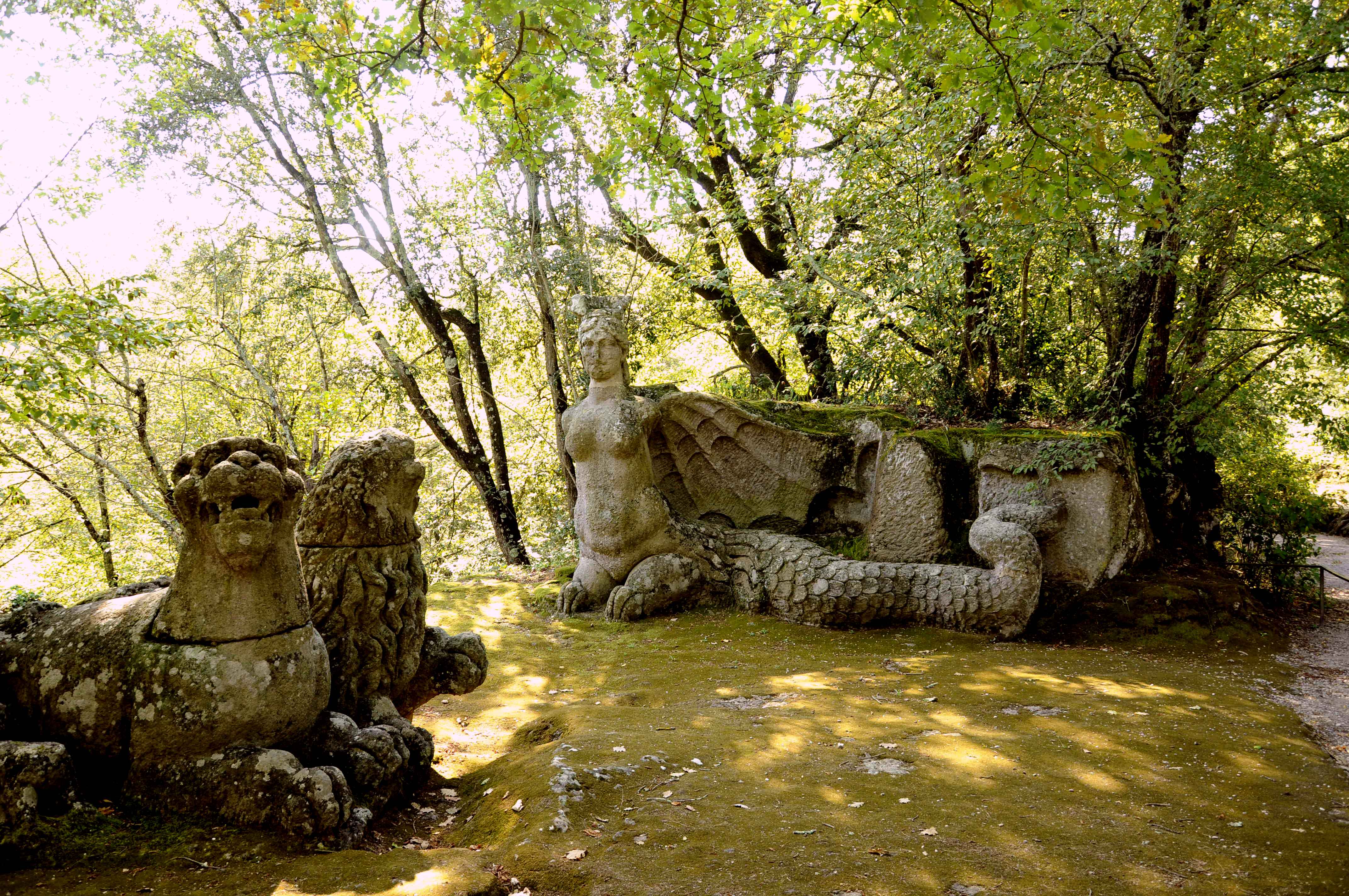
A little further under the ogre's mask, in a pleasant open space carpeted with moss and facing each other, two mythological figures: an Echidna e a Harpy. The Echidna is a figure of Greek mythology on which many legends have been grafted including its own origin. In the mythological lineage there would be more than one similarity between this and the images that will be used in the iconographies that will appear on the religious constructions of medieval Christian temples and not only in bizarre poses, equipped with a body whose lower form appears ending with two caudate ends that in many ornaments they are held apart with the hands. The "two-tailed sirens" refer to the ancestral idea of the Mother Goddess which manifested itself in the protohistoric context, these images will cross all eras up to the late Middle Ages.
From a symbolic point of view, beyond the lewd aspect, with the highlighting of the vulva, the image implies the symbolic power of generation (Venus Genitrix) through which birth can take place but also symbolically the realization evolution of the human condition. In this respect, the vulva would represent the primordial cave, the "place of origins", a sacred temple of female divinities in which the woman, in the double destructive-generative aspect, supervised the rites of passage. This process of a becoming that was represented by death to the world through the symbolic burial and rebirth from the uterus-temple of the Great Mother to new life, where the man / woman found the place of recapitulation and resolution in order to renew himself through a new birth [12]. On the other side, facing the siren, the statue of a harpy: scaly body, membranous bat wings, claws. Divinity of Greek mythology; two or three are mentioned, according to the author: Aello, “storm”, Ocipete, “she who flies fast”. In other authors Celeno “l'oscura” is also cited. They kidnap and transport the souls of the dead and sometimes the living to Hades. The image that is given is of a gratuitous cruelty in snatching loved ones from affection.

Towards the bottom of the park we find the Hermes, a sort of quadrangular pillars at the top of which a bearded face is carved. In ancient Greece the Hermes were symbolic representations of the abode of a god, in particular of Hermes, were also identified as betyls and were also venerated in Attica and the Middle East, were later exported to the Roman religion and pantheon. They were used as apotropaic protections of the streets and thresholds but also as a symbol of fertility. Among those of Bomarzo some respect the original characteristic of the Erme: they are two-faced, where the double face is turned one to the past and the other to the future. In Roman times the Hermes will be assimilated to the image of Janus, which will be a purely Roman cult whose veneration goes back to an archaic period, so much so that it is considered the father of the gods. Janus is related to initiations; in addition to this he has been associated with the function of protecting doors and passages.
In Bomarzo they also exist Hermes with four faces that would probably represent the four ages of life similarly the four ages of the manifestation as elaborated by Ovid: the golden age, the silver age, the bronze age and the age of iron. Among the seven Hermes that guard the place where they have been placed, the images of the Hours, guardians of Olympus and linked to the seasons. Whatever their function is read, it seems clear that the images refer to the use of time in general and that of man in particular. We cannot know whether in the rearrangement, which took place in the second half of the twentieth century, the Hermes were arranged in such a way as to reflect the original position conceived by Orsini, where a certain sequence could perhaps have suggested in some way a qualified time for man, including that of his death. However, once again, if it is about Hermes his function was that of psychopomp, or rather to accompany the dead to find the passage to the land of the dead.

One of the elements that has been almost completely lost in Bomarzo, over the centuries for various reasons, not least an inconsistent rearrangement, is that of water which, on the other hand, would have been present in large quantities in the numerous works of Ligorio. In hermetic symbolism, water became the archetypal element and creative support of all life: human, vegetable, animal. A symbolic element with a precise metaphysical caliber and a determining and vital element for man and for life in general, its symbolism represented, with sufficient sufficiency, the undifferentiated matter from which the whole arose. It has represented and continues to represent, through its symbolic and transparent depths, a mysterious and fantastic world in which reality, imagination and metaphysics intertwine in a condition whose fluid and slow essence seems to acquire superior values outside of time and of space. It evokes the ancestral memory of the muffled womb and is the image of the primordial silence over which the Logos hovered.
Both Orsini and Ligorio were aware of this, and Ligorio will make water the fundamental and symbolic element of the whole layout of his main masterpiece, or Villa d'Este. Water will be the element that in the Middle Ages will be taken as the myth of the fountain of youth which will constitute a literary topos of bestiaries and courtly novels. As the primordial waters gave life to the entire cosmos, so every spring water carries within itself the germ of life and wholesomeness with the ability to cleanse, dissolve, purify, sacralize. If in the early age the source became a sacred and mysterious place, to which all the animals of creation drank including man, thanks to the discreet shadows that wandered among the leaves and the murmurs of the waters, those places were populated by presences. mystery of nymphs and naiads, giving the sources themselves a native spirit their guardian as well as legends and stories. Even the bodies of water of Bomarzo, the fountains, the streams acquired a magic and mystery through a story that the stone of the sculptures suggests.
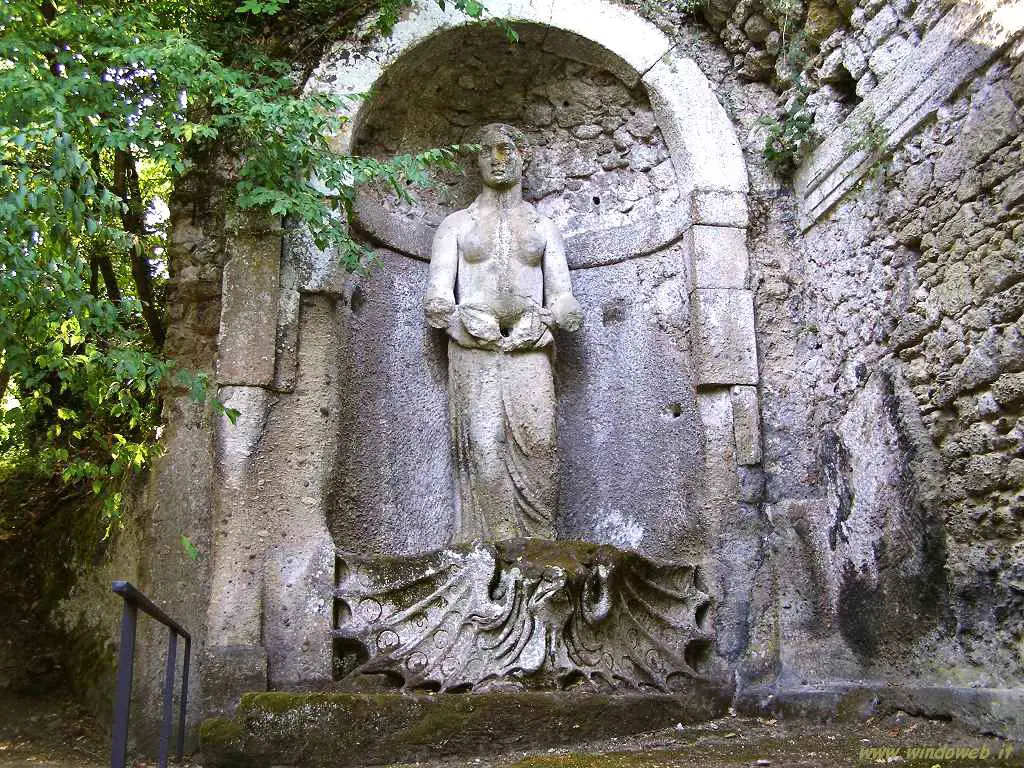
Among the many constructions in which water was a fundamental element, Venus leads to some considerations. Originally it was in a cave, now disappeared, of which only one of Jupiter Ammon's masks remains. Water gushed from her navel, flooding her. Venus symbolically carries with it the meaning of beauty and harmony or of divine proportion. Beauty (as harmony) in the Renaissance will be applied in every discipline: it is wisdom, and we would say, with the philosopher Heraclitus, that it represents the general law of the cosmos and the harmony to which both the natural world and the man. Concept that will extend into art, architecture, science. The Heraclitean idea will therefore remain in the Renaissance and will fit into the context of modern science. Kepler will resume the theory of the harmony of spheres and music which will remain and will be applied in the studies and works of Leonardo and Dürer. The Venus of water in the popular interpretation is charged with the maternal aspect and that of nourishment, in this case as intellectual nourishment. This aspect has been used as an allegory in alchemical science. In alchemy the water is called divine water or permanent. Divine water according to alchemists is found in matter as anima mundi and this proposition coincides with the idea of a universal matrix. It is the milk of the philosophers or the milk of the virgin, the mercury of the alchemists [13].
On the other hand, at the bottom of the square of the vases, seated in a basin, in which there is now only moss, he appears Neptune, the god of the sea, holding a baby dolphin in his hand (see cover photo). In truth, the image that appears to our eyes is different from the glorious and mythical images we have been accustomed to from Renaissance statues, indeed it looks like a Neptune that has lost its royal vigor, almost knocked down. What worry is he foreshadowed by? Does it have a meaning, the dolphin he leans on and the larger one with his mouth open to his right? Perhaps it is appropriate to make a reading combined with what is that near the square of the vases where the figure of Request which as maternal goddess is crowned by a basket with agaves whose meaning is that of the safety of the tangible symbol of a true and sure love, until death.
We can venture, as on the other hand we have already done, to see some images of the statues such as the traced figures of Orsini and his wife Giulia. In the group, in addition to Ceres, there are five children who cling to his back, perhaps to remember the numerous children that Giulia gave to Orsini? The dolphin he is a central figure of many ancient mythologies and religions, he is not a divinity in the proper sense, since he does not judge men, but limits himself to protecting them and accompanying them to the afterlife. The numerous legends and tales of ancient historians (Pliny, Eliano, Herodotus) tell us of the sociability and continuous closeness to man, so much so that they represent him on his back as he accompanies him to the "Islands of the Blessed" on the edge of the world. This veneration leads us to identify it as an emblem of the sea. We meet the dolphin in the Egyptian tradition as an attribute of Isis: protector of the dead, capable of resurrecting them; she embodies the feminine principle, the celestial source of fecundity and transformation, also the protector of sailors. Once again, the passage beyond the human dimension and perhaps in the hope, on the part of Orsini, of a reunion with his wife is emphasized..

At the end of our journey, accompanied by the Orsini, he appears on the upper part of the wooded area, near the external fence, the temple that is said to have been erected to collect the mortal remains of his beloved wife Giulia Farnese. Also in this construction, like a classical temple but which incorporates forms of different styles, a whole series of symbolisms is structured and it is the only classical style construction that contrasts with the strangeness of the rest of the wood. Meanwhile, in the pronaos we find a sort of forest of columns that seems disproportionate to the cell. Their number, depending on how they are counted, varies from eight, the free ones, to sixteen, including those merged into the cell. From a symbolic point of view, however, the octagonal cell seems to suggest eight, a number used in the baptisteries as a symbol of resurrection.
The whole construction seems to be linked to the eighth astrological house which concerns detachments, losses and our capacity for regeneration. It is astrologically oriented. This aspect is suggested to us by a drawing by the painter Giovanni Guerra, in which it is highlighted how originally the base of the temple was decorated with twelve heraldic medallions and twelve zodiac signs while the drum of the dome has four oculi oriented towards the cardinal points. In Christian art, the symbolic interpretation of the number eight has as its basis the words of St. Ambrose:
«… It was right that the hall of the Sacred Baptistery had eight sides, because true salvation was granted to the peoples when, at the dawn of the eighth day, Christ rose from the dead. "
The eight is therefore, at the same time, the symbol of the resurrection of Christ and of the promise of resurrection of man transfigured by grace. But it is also the number of the cosmic balance.
Here we stop: what remains among the green of the wood, as further suggestions, has the taste of a further but substantially repetitive side dish, since the Orsini and the Ligorio did not miss anything. What we have seen and considered in the charms of such a mysterious work, in our opinion, must be read and experienced having an intellectual key to its understanding, that is, through a symbolic language. Orsini's suggestion is this: force our conditioning in order to become aware of our life and our final destination, and to this end provide us with a symbolic interpretation key beyond any merely individual suggestion. Michael Majer, a famous alchemist, contemporary of Orsini, will suggest us, in the XXVII table of theAtalanta Fugens who welcomes the sage on the portal of the hermetic garden, the right attitude and the necessary wisdom with the phrase.
«Whoever tries to enter the Rosary of the Philosophers without a key is like a man who wants to walk without feet. "
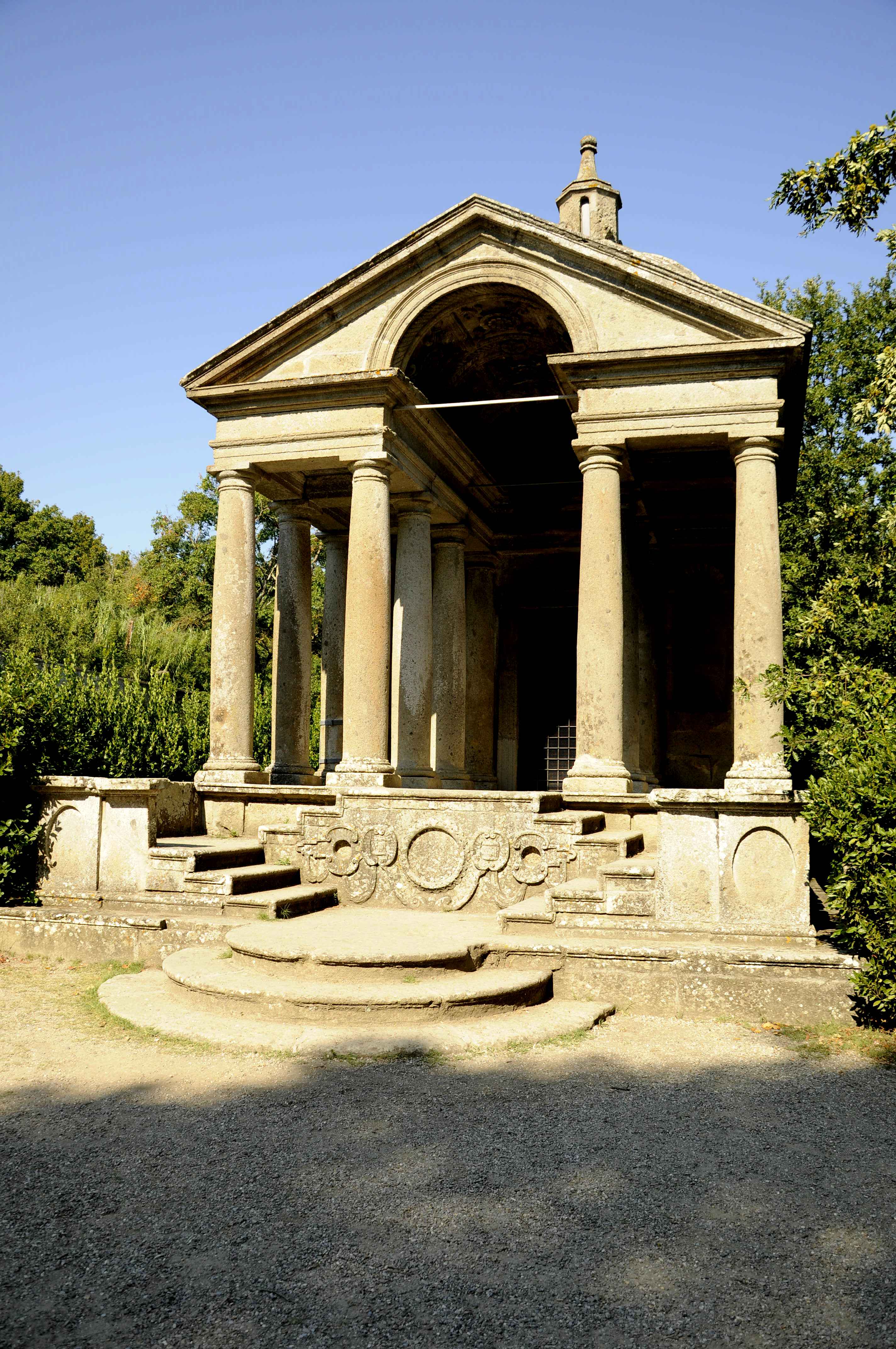
Note:
[1] It seems that the decision to leave the military career was encouraged by the cruelty of the reaction of Pope Paul IV in the story of the betrayal of the population of the town of Montefortino during the "war of Italy" of 1556-57 which opposed the pontiff to the Spanish vice kingdom of Naples. The inhabitants had passed, together with the local lord, belonging to the Colonna family, to the side of the Spaniards, killing in an ambush one hundred infantrymen belonging to the unit under the command of Vicino. The Pope's revenge was violent. Paul IV ordered the cavalry commander Giulio Orsini to storm and destroy the village and execute all the inhabitants, guilty of treason.
[2] Villa Palagonia by the Dominican architect: Tommaso Maria Napoli built it in 1715. Superb and eccentric villa already in the eighteenth century, it was visited by illustrious travelers, who considered it as the "most original place that exists in the world and famous throughout Europe". Its construction began in 1715 at the behest of Don Ferdinando Gravina and Crujllas, XNUMXth Prince of Palagonia.
[3] Not without irony Orsini calls those who visit thugs and they understand nothing of his forest, challenging Alessandro Farnese and his erudition to visit it (Letter of 22 April 1561).
[4] It is clear that it was, but even today in this short essay it is an intellectual path with a strong symbolic-literary component that derives from the stories mythological typical of the 500th century cenacles. In the inspiring component of the statues there are traces of works by Song book by Francesco Petrarca, of theOrlando Furioso by Ludovico Ariosto. The abundant critical literature in which we will try to extricate ourselves, with reference to both the artistic and historical Bomarzese structure, would seem to be rather stingy in a symbolic and metaphysical vision, despite the precedents of interest from Orsini for the alchemical sciences and references as we have already mentioned to the work of Francesco Colonna, theHypnerotomachia poliphili as well as poems Amadis e Floridant by Bernardo Tasso.
[5] The house has an inclination of 10 degrees which causes the loss of any frame of reference, sending the neuronal balance process of the vestibular labyrinth into a tailspin. These types of phenomena have been studied four centuries later since psychologist Bruce Bridgeman and a certain DB Vogt.
[6] Orsini will be very critical in the worldly aspect of the papal court. In the copious collection of letters that he will entertain with Jean Drouet, a cleric and doctor originally from Savoy residing in Rome, philosophical, literary, medical issues, his relationships with women and, above all, are treated with a unique style for the epistolography of the time. the merits of life withdrawn from the world of wealth and power, represented by Rome and the papal court, for Orsini a symbol of hypocrisy.
[7] Sul Hindu Kalāmukha, cfr. MACULOTTI, Marco: Cyclical time and linear time: Kronos / Shiva, the "Time that devours everything"; on AXIS mundi.
[8] The myth has it that Hercules, once his labors were over, as a result of a poisoned robe, allowed himself to be burned on a pyre on Mount Eta due to great pain.
[9] The meaning of the turtle's shell derives from its particular design. The 13 largest scales are the 13 full moons of the year. The 28 small horny scales on the perimeter are the 28 days according to the lunar calendar.
[10] The tower applied on the elephant's back is called Howdah, derives from the word then "hauda"And it was a real turreted wooden structure designed to protect archers and javelin throwers.
[11] The snake in Christian iconography is reported as a symbolic image of Christ. On some glasses of the thirteenth century it is reported: Serpens Christum notat in crucem passum (The serpent indicates the Christ who suffered on the cross).
[12] The female therefore represented, at the dawn of humanity, for her procreative abilities, the celebrant of the mysteries of nature, becoming the vestal sacra of the latter. If, we transport ourselves to the Paleolithic, approximately 40.000-35.000 years ago, in the European continent, we can find very interesting iconographic evidence inside caves that appear decidedly dedicated. In this regard, the images found in the cave of Abri Cellier dating back to the Aurignacian period (47.000-35.000 years ago) carved on a wall are significant. That is the main symbol, the door, the manifestative ostium: the vulva. Over the millennia this image will change, without losing its symbolic caliber, in several forms; from the abundant prehistoric female figures, to the representations of the Mother Matuta Roman or la sheela na gig medieval. See MACULOTTI, Marco: The symbolism of the Spiral: the Milky Way, the shell, the "rebirth"; on AXIS mundi.
[13] The alchemical concept of the nurse appeared in theAurora Consurgens at the end of the XNUMXth century. It is a hymn to the Sophia studded with passages from the Song of Songs of Solomon. In some paintings, knowledge is a virgin from whose breast the philosophers suck. The Sophia puts an end to the night of ignorance and the destructive putrefaction of matter, feeding the philosophers with her "virginal milk".
Bibliography:
- Speeches by M. Francesco de 'Vieri known as Verino Secondo, of the marvelous works of Pratolino and d'Amore In Florence, near Giorgio Marescotti, 1587
- BALTRUSAITIS Jurgis, The fantastic Middle Ages. Antiquity and exoticism in Gothic art, Milan: Adelphi, 2002
- BURCKHARDT Titus, Sacred Art in the East and West. The aesthetics of the Sacred, Milan: Rusconi, 1976
- CHARBONNEAU Lassay Louis, The bestiary of Christ.
- COLUMN Francis, Hypnerotomachia poliphili.
- COOMARASWAMY Ananda K., The big thrill.
- EUSEBIO M. Roberto, The eternal feminine, rev. The eternal Ulysses, year 5 n ° 18.
- EUSEBIO M. Roberto, The universal ocean.
- BEAN Marcello, Architecture and Freemasonry. The esotericism of construction, Rome: Gangemi, 2006
- GUÉNON René, Symbols of sacred science.
- IMPELLUS Lucia, Nature and its symbols. Plants, flowers and animals, Milan: Electa, 2003
- ROOB Alexander, Alchemy and Mysticism, Cologne: Taschen, 2007
